Community Government Transportation
Circle logic: Why Gig Harbor has so many roundabouts
Readers who have seen the 1985 hit movie “National Lampoon’s European Vacation’’ may recall a funny scene in which Chevy Chase, as an American tourist unfamiliar with roundabouts, rents a canary-yellow car and tries to use London’s Lambeth Bridge roundabout to leave town with his family.
And tries. And tries. Chevy just can’t figure out how to exit safely from the thrumming roundabout.
Hours pass and day turns to night. Big Ben glows majestically in the dark London sky as the lights of the British capital flicker to life. And still the little yellow car goes ’round and ’round in circles.
Borgen’s run of roundabouts
Drivers on Gig Harbor’s car-clotted Borgen Boulevard can relate.
It’s not as bad as Chevy Chase’s comically exaggerated dilemma in the movie. But Borgen Boulevard, with about half of Gig Harbor’s dozen or so circular intersections, is Roundabout Central hereabouts.
The 1.3-mile stretch of Borgen from Peacock Hill to State Route 16 has no fewer than six roundabouts. Starting at a cozy single-lane traffic circle atop Peacock Hill Drive, a Route 16-bound driver motors downhill. One must squeeze through the narrowed opening — caused by water damage under the road — just before the next roundabout at Olympus Way.
Then, still going, the driver yields just before easing onto a third and busier circle near the entrance to the Albertson’s shopping center.
For a driver going the distance, that’s maybe halfway to 16.
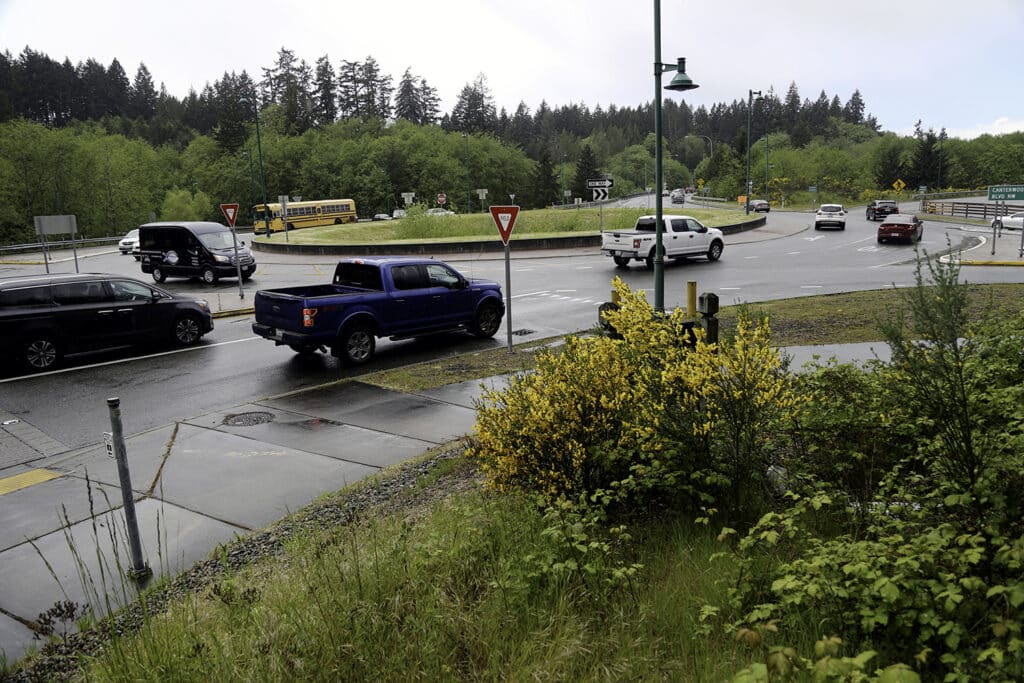
Traffic moves through the roundabout on Borgen Boulevard near the ramp to westbound Highway 16. Vince Dice
The fourth, fifth and sixth roundabouts further downhill grow ever-busier, sprouting more lanes. During morning and evening rush hours — especially in recent months, due to a temporary detour during construction of the new $2.1 roundabout downtown at Harborview Drive and Stinson Avenue — heavy traffic waiting to enter the lower Borgen Boulevard roundabouts can back up to the Albertson’s entrance and beyond.
Fewer serious collisions
This gives rise to worries about how emergency vehicles can get into that part of the city. And how people urgently trying to leave in, say, a major fire or an earthquake could get out.
Congestion is somewhat ironic, given that roundabouts are designed to keep traffic continuously moving. Intersections with traffic lights and stop signs require drivers to stop and start.
Champions of roundabouts — including nearly all traffic engineers and many government officials, locally, nationally and statewide — are unfazed. They say roundabouts are faster and safer than stop-and-start intersections in most situations.
Moreover, traditional intersections have problems, too. Who hasn’t seen drivers roll through a stop sign or floor it when the light turns yellow or even red?
“Each intersection control device has its advantages and disadvantages,’’ observes Brian Walsh, a state traffic design engineer for the Washington State Department of Transportation.
“Roundabouts, when looking at fatal crash or serious injuries, are clearly safer and they manage speeds much more consistently, which benefits all modes using the intersection,’’ he writes in an email. “Intersection control decisions require trade-offs, and while handling the required number of cars is important, there are other considerations in play.’’
Lower maintenance cost
One consideration is cost, says Gig Harbor’s public works director, Jeff Langhelm. While building a roundabout or a traditional intersection with traffic lights and signs costs about the same, roundabouts are cheaper and easier to maintain.
Roundabout don’t require continuous electrical power, which has to be paid for. Also, electrical power can fail during a powerful storm with heavy rain and gusting winds.
More broadly, Langhelm shares the state DOT’s high opinion of roundabouts, for two reasons.
“One is safety: reducing the severity — not the number, maybe — of collisions.’’ Yielding when entering a roundabout, always moving, only turning right and driving counter-clockwise at speeds from 15 to 25 mph virtually eliminates head-on collisions. “The impacts are much different,’’ he says.
“The second reason is traffic flow. We look at delays, and count them in seconds. Cars can back up in queues and experience serious delays,’’ he says. “It could be hundreds of seconds.’’
To enter Harborview Drive from Stinson Avenue, drivers waited an average of 1 minute 48 seconds. A city study concluded the wait would grow to more than three minutes over the next nine years. Thus, Gig Harbor’s decision to build the new roundabout at that busy, awkwardly configured intersection.
Most studies and statistics published in recent years favor roundabouts when it comes to improving safety — and limiting environmental impacts. In Carmel, Ind., the national leader with some 140 roundabouts for 102,000 residents and numerous visitors, city leaders contend that toxic exhaust is reduced when drivers keep moving instead of idling their engines while they wait.
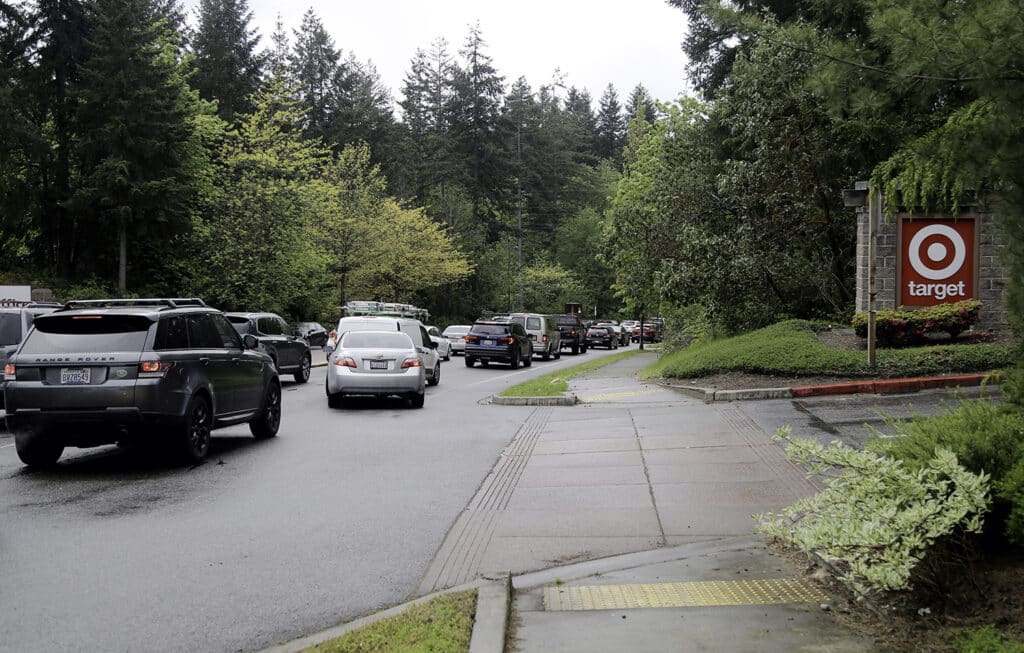
Roundabouts have been statistically proven to reduce traffic congestion, though people stuck in backups like this one on Borgen Boulevard on May 19 might find that hard to believe. Vince Dice
Many drivers dread roundabouts
All that said, politicians and engineers are still much keener on roundabouts than the public as a whole. Indeed, statistics are cold comfort to drivers who find themselves in hot situations.
Janet Heckscher, a Gig Harbor resident who cut her teeth driving on the twisting, historic streets of Boston, is not a fan of circular intersections.
“I can see the value of them, if everybody would behave themselves,’’ she remarks. “My major problem is people refusing to let me know what they’re doing by signaling.’’
Heckscher finds navigating the multiple roundabouts on Borgen Boulevard downright vexing.
“Even in Boston, they didn’t have one roundabout after another. It’s tough,’’ she concludes. “You really have to know what you’re doing. It’s scary.’’
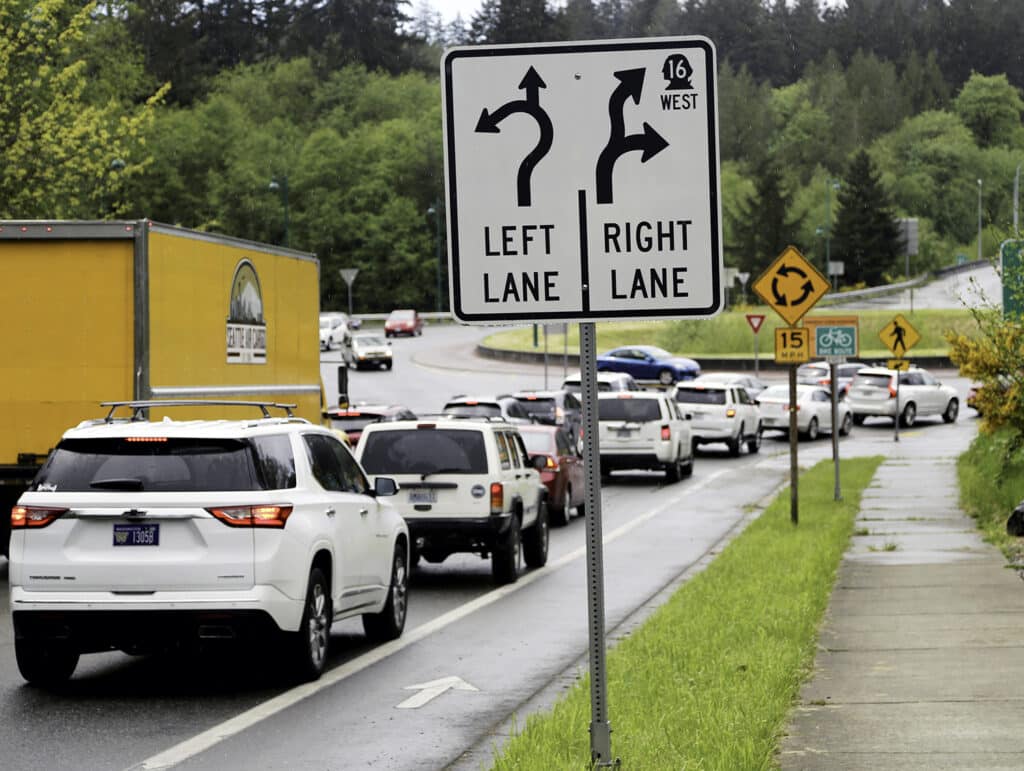
Vehicles wait to enter the roundabout on Borgen Boulevard near the exit to westbound Highway 16 on May 19. Vince Dice
Another local resident, who wants to remain anonymous, recalls stopping suddenly in a roundabout to prevent an imminent collision. The angry driver just behind her followed her into the parking lot at a nearby shopping center and walked over to her car shouting “Don’t you know you never stop in a roundabout?”
She apologized through rolled up windows, and the other driver stalked off, fuming.
Borgen’s history
Brian Kelly, the state DOT traffic engineer, is familiar with Gig Harbor’s abundance of roundabouts — and problems that can crop up.
“I drive through three roundabouts regularly in my drive around town where I live, and I see the wide variety of skills and passive and aggressive behavior,’’ he says.
He continues, “From my understanding of the history of Borgen Boulevard, it was first constructed as a roundabout corridor in 2001. Borgen was a new road utilizing an existing interchange which was converted to a roundabout to match the corridor and its needs. The corridor was again modified in 2010 with a lane addition or two and a couple of bypass lanes.’’
Jeff Langholm, a 16-year city staffer who was a senior engineer in 2010 before becoming public works director in 2013, remembers the changes.
Referring to the city’s first, and most heavily trafficked, roundabout at the Burnham Road exit and entrance ramps linked to Highway 16, Langhelm says the city has looked hard at the pioneer roundabout with an eye toward upgrading it.
“It’s got six legs of traffic, that’s an anomaly. In 2010, the cost of (doing a makeover) was estimated to be $50 million. It’s got to be at least twice that now,’’ he says.
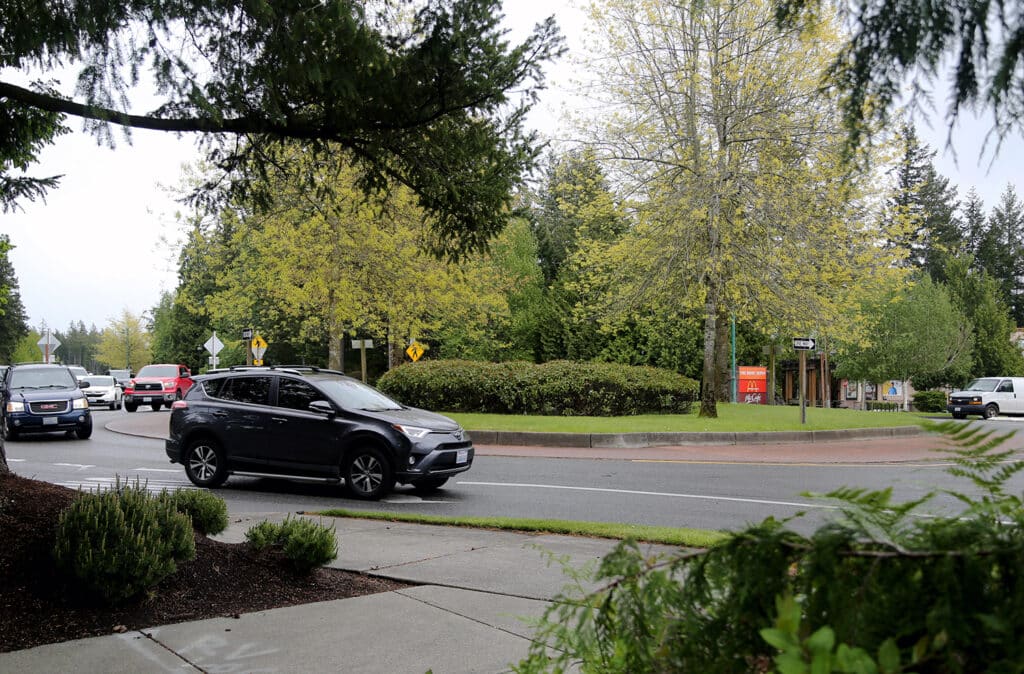
Vehicles move through the roundabout near the Target store on Borgen Boulevard. Vince Dice
Metering could be an option
Short of raising big money, the city could try another tack, suggests Kelly: Namely, metering.
“We have a similar roundabout interchange in terms of daily volumes in Eastern Washington that drew an increase of 60% of traffic in a very short span of time as the newly opened roundabout at the ramp and corridor it served became the ‘faster’ route for many drivers using the regional freeway system.’’
Some 10 years after installing the increasingly popular — and increasingly crowded — roundabout, WSDOTdecided to install a metering signal and employ it during peak rush hour back-ups — about 45 minutes a day.
Kelly didn’t say which town, but published reports indicate that the first permanent roundabout meter was installed in the Tri-Cities in 2018. It worked.
Gig Harbor has mulled metering roundabouts for the past several years. In 2021, Gig Harbor requested $3 million to install an automated metering system at the westbound Highway 16 off-ramp at Burnham, but the money has not materialized.
500 roundabouts in Washington
Talk of roundabouts in traffic management and political circles isn’t about whether roundabouts should be embraced wholeheartedly — that’s a given — but how they might be tweaked.
Critics and queasy drivers may well feel they’re driving the wrong-way up a one-way street when it comes to suggesting that roundabouts are something less than a magic bullet. Such is the support for roundabouts.
Something of a traffic nerd roundabout subculture has sprung up in America since the first U.S. roundabout opened in the Nevada city of Summerlin, bordering Las Vegas, in 1990.
Momentum has only accelerated since then. An International Roundabout Conference was held this week in Monterey, Calif. National Roundabout Week is scheduled for the third week in September.
Washington had some 500 roundabouts at the start of 2022 and expects the number to rise to 550 by year’s end, according to Kelly. The state’s first roundabouts were built in the late 1990s.
Federal support
Also in the late ‘90s, the National Highway Administration, part of the U.S. Department of Transportation, began actively promoting roundabouts, not just with words but with money.
Neil Gaffney, a NHA press officer, explains: “Communities can be reimbursed for between 90 percent and 100 percent of the expenses incurred for constructions of roundabouts, and they are often built as parts of projects implemented through the Highway Safety Improvement Program. Communities can also use Congestion Mitigation and Air Quality Improvement Program funds to install roundabouts.’’
Given all that support, it’s full speed ahead for roundabouts.
For laggards who worry that motorcyclists, bicyclists and pedestrians are especially at risk in and near roundabouts, Jeff Langhelm counters that any such issues can be remedied.
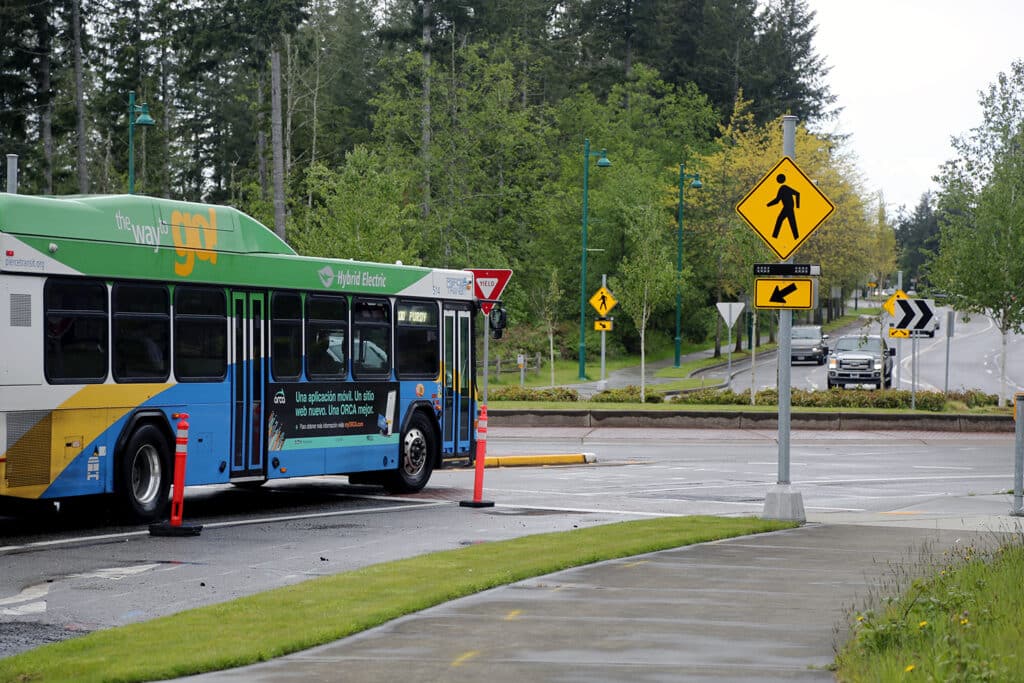
A Pierce Transit bus navigates one of the roundabouts on Borgen Boulevard on May 19. Vince Dice
Langholm points to recently installed flashing lights at designated crossing points for pedestrians in busy stretches of Borgen Boulevard, adding that in many situations dismounted “bicyclists walk their bikes and essentially become pedestrians.’’
As for motorcyclists using roundabouts thick with trucks and hulking SUVs, he remarks, “I myself am a motorcyclist. I don’t have any problems with it.’’
More roundabouts coming
Langhelm says that several more new roundabouts are on tap for Gig Harbor.
The downtown roundabout broke ground last summer. Work resumed Feb. 28. The roundabout is expected to be partly open around Memorial Day, according to Langhelm.
Flag-wielding workers will be on the job until July. Referring to Tacoma’s Active Construction, the contractor at Harborview and Stinson, he says, “They have a lot more work to do.’’
Several more new roundabouts are lined up after this year. Among them, a new roundabout at Hunt Street and 38th Avenue, and another at Harborview and Austin Street. Of the latter, Langhelm says, “We’re not planning on doing that one anytime soon, as it doesn’t have high traffic.’’ But it will happen.
Roundabouts: love them or hate them, here they come.
